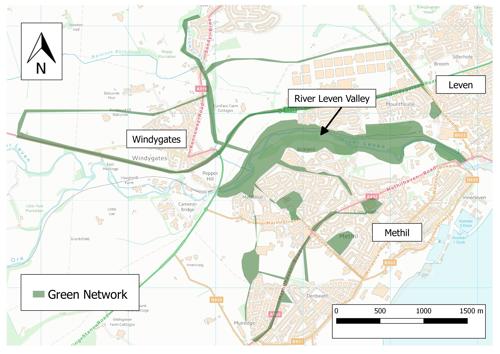A green network is a paths network that brings people into contact with nature. It should allow people to appreciate, view and learn about nature and wildlife as they go from place to place. The development of a well-designed green network between Cameron Bridge and Levenmouth, and running along the River Leven, is currently being planned as part of the Leven Connectivity Project. This will enable locals and visitors to access the heart of a vastly underrated wildlife haven along the river.
Aims and objectives of the network
The Leven Green Network aims to bring people and wildlife together, by making it easy for people to get out and about around the river. As well as benefitting their physical and mental health, people are encouraged to understand and care about nature. The network therefore has two main focal points – people and wildlife - and aims to make improvements for both.
The network aims to:
- encourage people to use the existing path network and future upgrades by engaging with them with about the great wildlife that can be found in and around the River Leven valley, and further afield;
- identify teaching and training opportunities;
- identify improvements and management options for wildlife, particularly those that can involve volunteers from local communities;
- help people to care about wildlife and the environment in their local area, and to get out into nature more often;
- identify any wildlife constraints on developments being carried out as part of The Leven Programme, and provide advice to avoid works causing undue damage to local wildlife.
Where does The Leven Green Network cover?
 The network encompasses the River Leven from the A915 in the West (Cameron Bridge), along the river valley through surrounding floodplain, woodland, urban and old industrial sites to the mouth of the river in the East. It also penetrates into the surrounding towns through greenways of various types.
The network encompasses the River Leven from the A915 in the West (Cameron Bridge), along the river valley through surrounding floodplain, woodland, urban and old industrial sites to the mouth of the river in the East. It also penetrates into the surrounding towns through greenways of various types.
What has been done so far?
In 2019, the Forth Rivers Trust (FRT) were tasked with undertaking a Green Network assessment and producing a report of the Connectivity Project area. A series of surveys were carried out to establish the range of wildlife on site and any associated factors involved.
The primary species found were:
- Otters: Otters are present and use the area heavily. The river provides a good food source, cover and shelter with the river banks suitable for holts and rest sites among the trees and in the grass.
- Breeding birds: The bird survey identified that habitats within the Green Network are very diverse providing a high quality site for wildlife. 50 bird species were recorded during May and June. The vast majority of birds were spread evenly throughout the entire area. The conclusion of the survey was that the diverse habitat mosaic of the Green Network should be preserved in order to allow the bird fauna to persist. A general lack of mature trees can be improved by the installation of nest boxes.
- Bats: Three species of bat were recorded: common, pipistrelle and Daubenton’s. The river provides an excellent commuting route with plenty of insects but roost sites are not readily available as there are large areas of young planting and few mature trees. Bat boxes would increase the amount of suitable roost sites for bats.
- Amphibians: Ponds, marshes and ditches within the Green Network include a SUDs pond, Methilhill wetland, an old lade and a flooded path. Furthermore, ditches and farrows within the woodland areas provide good habitats for toads and frogs. Common frogs and toads are present, but there are no newts within the area or in the wider setting.
- Terrestrial insects and pollinators: A great diversity of insect life, and flowering plant communities are present in the area. The wide variety of habitat available is important for supporting these invertebrates, in particular the steep south facing banks, the old railway line and the creosote site.
- Fish: There is a diverse fish community within the River Leven including salmon, brown / sea trout, lamprey, eels and flounder. Dams create barriers to fish migration upstream, requiring removal or the fitting of a fish pass. There are two dams or weirs within the site, on the main stem of the River Leven.
- Aquatic insects: Aquatic insect life is considered to be of a reasonable standard. There is some pollution resulting in sensitive species being either absent, or present in very low numbers. In the last two years, there have been reports of a large mosquito hatch from the river which certainly gives cause for concern.
- Roe deer: Roe deer are the only deer species that have been observed on site. Their numbers are quite low and they have only a small impact on site vegetation. Any new planting would need to be protected from deer grazing.
- Invasive non-native species: All three common invasive non-native species (INNS) of weed are present in the Leven Green Network (Giant hogweed; Japanese knotweed; Himalayan balsam). These will be managed throughout the project by FRT.